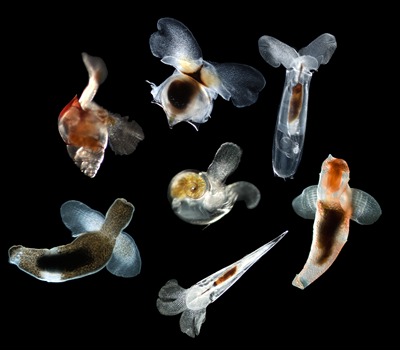Pteropods, abundant aragonitic calcifying plankton, are the equivalent of "canaries in the coal mine" for our acidifying oceans. Their sensitivity to high CO2 levels and limited fossil record has led to the widely held view that pteropods only became abundant after the Paleocene-Eocene Thermal Maximum (PETM, approximately 56 million years ago), the closest analogue to modern-day ocean acidification and warming. An international team of researchers have shown, based on an extensive molecular dataset (2654 genes) and new fossil evidence, that the two major groups of pteropods (sea butterflies and sea angels) have Cretaceous origins and hence, must have survived previous global change events in Earth's history. These findings indicate that pelagic aragonitic calcifiers have shown remarkable resilience to perturbations in the Earth's carbon cycle over evolutionary timescales.
Pteropods as sentinels of the impacts of ocean acidification
Pteropods are marine gastropods that spend their entire life in the open water column. A remarkable example of adaptation to pelagic life, these mesmerizing animals have thin shells and a snail foot transformed into two wing-like structures that enable them to "fly" through the water column. Pteropods are a common component of planktonic foodwebs worldwide and are major contributors to pelagic calcification. Hence, they play important roles in the ocean's biological carbon pump.
Shelled pteropods have been a focus for global change research because they make their shells of aragonite, a metastable form of calcium carbonate that is 50% more soluble than calcite. As their shells are susceptible to dissolution, pteropods have been called "canaries in the coal mine" or sentinel species that signal the impact of ocean acidification on marine calcifiers. Although shelled pteropods are already negatively affected in several regions of the global ocean, and will likely be seriously threatened if CO2 levels continue to rise, little was known about the evolutionary history of the group. Knowing whether major groups of pteropods have been exposed to periods of high CO2 is important to extrapolate from current experimental and observational studies to predictions of species-level responses to global change over longer timescales.
Sea butterflies and sea angels diverged in the Early Cretaceous
 In addition to having thin, aragonitic shells, some groups of pteropods have only partial shells or are naked as adults (such as the sea angels), which leaves us with a patchy fossil record. Abundant pteropod fossils are only known from the Eocene onwards (from 56 million years ago) and mostly represent the fully-shelled species (sea butterflies). This has led to the notion that pteropods are a relatively recent group of gastropods. However, resolving the timing and diversification of pteropods accurately required a combination of molecular and fossil-based approaches.
In addition to having thin, aragonitic shells, some groups of pteropods have only partial shells or are naked as adults (such as the sea angels), which leaves us with a patchy fossil record. Abundant pteropod fossils are only known from the Eocene onwards (from 56 million years ago) and mostly represent the fully-shelled species (sea butterflies). This has led to the notion that pteropods are a relatively recent group of gastropods. However, resolving the timing and diversification of pteropods accurately required a combination of molecular and fossil-based approaches.
This new study sampled 21 pteropod species across two basin-scale ocean transects as part of the Atlantic Meridional Transect and collected information on 2654 genes. The researchers employed a phylogenomic approach, that was calibrated using key pteropod fossils, showing that the two major groups of pteropods, sea butterflies and sea angels, diverged in the early Cretaceous (approximately 139 million years ago). Hence, both groups are much older than previously thought and must have survived previous episodes of widespread ocean acidification, such as at the end of the Cretaceous (K-Pg, 66 million years ago) and the Paleocene-Eocene Thermal Maximum (PETM, 56 million years ago).
Although these results suggest that pelagic aragonitic calcifiers have been more resilient to past ocean acidification than currently thought, it is unlikely that pteropods have experienced global change of the current magnitude and speed during their entire evolutionary history. Lead author of the study, Dr. Katja Peijnenburg from Naturalis Biodiversity Center in the Netherlands, explains "current rates of carbon release are at least an order of magnitude higher than we have seen for the past 66 million years". Hence, she stresses to add the disclaimer "past performance is no guarantee of future results".
Climate change and the ocean's role
It is sometimes forgotten that the ocean plays a major role in regulating the climate and supporting life on our planet. The open ocean is the largest habitat on Earth, microscopic algae produce half of the world's oxygen, and the ocean has already absorbed more than 90% of excess heat and 30% of excess CO2 from the atmosphere since global industrialization. However, this is not without consequences.
In the past, changes in ocean processes, including circulation, the biological pump and calcium carbonate precipitation were responsible for fluctuations in atmospheric CO2. Now, for the first time in millions of years, the role of the ocean and atmosphere has been reversed: today it is the atmosphere that controls ocean chemistry leading to an increasingly acidified ocean. It is still an open question whether marine organisms, particularly those that calcify, have the evolutionary resilience to adapt fast enough to these changes.